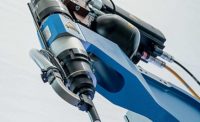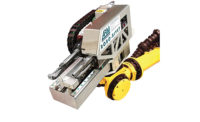Self-pierce riveting (SPR) is a cold joining process for fastening two or more sheets of material by driving a rivet through the top sheets and upsetting it, under the influence of a die, into the bottom sheet without breaking through it. The technology can join a stack of aluminum sheets up to 12 millimeters thick or a stack of steel sheets up to 6 millimeters thick.
An alternative to spot welding, SPR does not transmit heat to the product. It forms strong, fatigue-resistant joints without affecting intermediate layers or distorting the materials.
The process joins dissimilar materials, as well as materials that have been lubricated, painted, coated or plated. SPR can be used on joints that include sealants, adhesives or insulation. The process can join high-strength steel, galvanized steel, aluminum, plastics and composites.
Because SPR does not require punched or drilled holes, assemblers can save overall manufacturing time compared with blind rivets and other fasteners. This lack of a through-hole also ensures a leak-proof joint.
However, the process does require access to both sides of the assembly.
An SPR system typically consists of a C-frame press equipped with a riveting head and an upsetting die. Tooling can be customized to access most any area of an assembly.
Riveters are available as handheld tools (both corded and cordless) and as standalone pedestal systems. Riveters can also be mounted to a six-axis robot for fully automatic assembly. Rivets can be supplied to the setting tool on tape or with a vibratory bowl and blow-feeding system.
Rivets are made from high-quality grades of steel wire that have been forged, hardened and tempered to provide optimum joint properties. They can also be made from austenitic or martensitic stainless steel, copper, or aluminum. A variety of head styles are available to meet functional or aesthetic requirements. Even studs and T-studs are available.
A Little Warmth
Many variations on the process are being introduced to broaden applications for the technology.
In May 2020, for example, researchers from the University of Lisbon in Portugal unveiled their take on the technology: double-sided SPR. In their process, tubular rivets with simple geometry are placed in-between two sheets to be joined. The sheets are then pushed against each other by flat parallel punches, so the rivets are forced through the sheets and their ends are flared to create mechanical interlocking that holds the sheets tightly together.
The new process maintains the advantages of conventional SPR and overcomes its main disadvantages: small protrusions above and below the sheet surfaces and difficulty in joining sheets of dissimilar materials with large thicknesses. The rivets are hidden inside the cross section of the overlapped sheets. So far, the researchers have tested their process using AA5754-H111 aluminum sheets and AISI 304 stainless steel tubular rivets.
In October 2019, researchers at Shanghai Jiao Tong University in China debuted another variant, thermally assisted SPR, designed to rivet ultrahigh strength steel (UHSS), a key material for lightweight automotive designs. The researchers used an induction coil and conventional SPR equipment to rivet sheets of AA6061-T6 aluminum and DP980 UHSS. The researchers discovered that preheating the UHSS sheet made the tough material more amenable to riveting. By adjusting heating current, heating time and coil distance, the researchers were able to create crack-free joints having 78 percent higher undercut and 24 percent higher lap-shear strength than joints using the conventional SPR process alone.
Researchers at the Austrian Institute of Technology in Vienna took a similar approach to riveting magnesium alloys which, like UHSS, have high strength but low ductility. In October 2020, they reported on a technique to briefly apply localized, one-sided, electric resistance heating to each fastening point prior to inserting the rivet. The heating lowered the hardness of the materials and enabled piercing and penetration of the sheets to produce crack-free joints. The brief, localized heat did not alter the mechanical properties of the base materials.
Researchers at Robert Bosch GmbH in Renningen, Germany, do not use heat, but rather vibration, to augment rivet installation. Florian Woelke, a technical project manager at Bosch, came up with the idea of applying ultrasonic energy to help drive the rivet into the materials. When the rivet contacts the materials, the punch applies vibrations at a frequency of 20 kilohertz and an amplitude of 0.1 millimeter. The vibrations excite the head of the rivet, so that, instead of applying ever more pressure, the rivet is coaxed through the material. The technique can join materials that are difficult to bring together, such as carbon-fiber composites and steel, or aluminum and magnesium.
New Materials
Other researchers are investigating the feasibility of using self-pierce rivets to fasten new materials.
For example, in June 2019, researchers at Kunming University of Science and Technology in China demonstrated that SPR could be used to assemble sheets of aluminum-lithium alloy. Lithium alloys are significantly less dense than aluminum, and they are valued by aerospace manufacturers for their light weight. According to metal supplier Arconic, the alloy is 10 percent lighter than composites and less expensive than either titanium or composites. Airbus uses aluminum-lithium alloy for the lower wing skins of the A380 and the inner wing structure of the A350, while Boeing is using it for the cargo floor of the 777X.
In August 2020, the same researchers showed that SPR could be used to fasten nickel-iron foam and copper foam to aluminum sheets. In vehicles, metallic foams are used to increase sound damping, reduce weight, increase energy absorption in case of crashes, and (in military applications) to combat the concussive force of explosive devices. Compared with polymer foams, metallic foams are stiffer, stronger, more energy absorbent, and more resistant to fire and weather.
Researchers at Yanshan University in China have determined that, when using SPR to fasten carbon-fiber-reinforced polymer (CFRP) to aluminum sheets, timing is everything. The issue with using rivets to fasten CFRP is that piercing the material breaks the fibers, which are what give the material its strength. In an October 2020 report, the researchers describe how they got around that problem. Instead of riveting the fully cured and hardened composite, they rivet the pre-preg material and then cure the assembly in an autoclave. By riveting the material when it can flow, delamination and tearing of the fibers by the rivets are reduced, joint quality is improved, and joint strength is increased.






